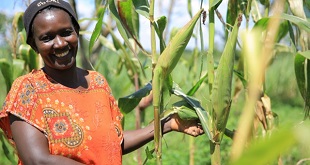
By Mubatsi Asinja Habati
In todays world with improved technology that enables breeding of improved and drought resistant seed varieties, there is no reason for anyone to go hungry. Yet more than 1.6 billion people worldwide are hunger stricken. And some 8 million Ugandans are at the verge of hunger. The biggest number of Ugandan households that are food insecure are found in Karamoja, Budaka and Busoga regions.
A hunger free scorecard released by Action Aid Uganda, an international aid agency, on the eve of World Food Day indicates that despite Uganda’s enormous food production potential, the country scored 46 out of 100 percent. Though Uganda ranked 7th out of the 29 developing countries investigated, the scorecard shows it can do more to position itself as East Africa’s food basket since it has all the potential.
Besides food crisis, the number of people grappling with chronic malnutrition around the world has increased by 20% since 2005 while additional 170 million people (equal to the population of Germany, France and Canada combined) have been pushed into hunger. The agency warns that if world leaders do not pay more attention to solve the problem, the situation will get worse.

Famine recently ravaged Teso and Karamoja sub-regions with people resorting to eating tree leaves and many reportedly dying of hunger. In response, the government released Shs 10 billion to fight hunger in the area but local leaders complain they have not seen the money, or what it has done.
The report says hunger is a choice other than a force of nature since countries have shown that resources do not mean a lot in food production. China with an arable land of 9% can feed its 1.3 billion people and provide food for about 20% of the worlds population.
Hunger begins with inequality between men and women, and between rich and poor. It grows because of perverse policies that treat food purely as a commodity, not a right. It is because of these policies that most developing countries no longer grow enough food to feed themselves and that their farmers are amongst the hungriest and poorest in the world while the rich world fights growing obesity, the report reads.
China has cut its number of people considered hungry through adopting polices like relative distribution of land, government support to smallholder farmers, investment in rural infrastructure, and building grain reserves. This has also been the case in Ghana and Malawi that ranked 3rd and 5th respectively.
Related Story: World Food Day finds Uganda women hungry
Investing in the poor farmers is the solution, as in Leah Chedde’s experience who utilizes the knowledge acquired from an adult literacy learning centre in Pallisa district to plant better seeds from which she has ably built a two roomed iron roofed house and paid tuition for her high school and university children.
According to the report, a country’s ability and commitment to fight hunger does not depend on wealth. Some relatively poor countries like Ghana and Malawi have made remarkable progress. Yet some rich countries have “allowed rural misery to deepen in the midst of growing wealthâ€. The Scorecard quotes Pakistan as performing not any better than the poor and conflict-torn countries like Sierra Leone, despite having a per capita income of over 2.5 times higher. India ranks 34 just below Ethiopia and Cambodia.
Brazil topped the list of 51 countries setting the precedent of what can be achieved if the state has political will to tackle hunger. The Brazilian president, Lula da Silva, made it his objective to wipe out hunger and within 6 years his Zero Hunger programme he has introduced food banks, community kitchens and locally produced school meals alongside smallholder farmers and land reform settlers. As a result Brazil’s child malnutrition has fallen by 73%.
Ghana ranks third on the Scorecard. The secret behind Ghana’s better performance was its making of food security a national priority backing it with consistent support to smallholder farmers and democratic stable governance. As a low income country, Ghana has made tremendous strides in reducing hunger. Malawi which is in the 5th position and burdened with HIV/AIDS has reaped big within three years. It massively invested in smallholder farmers and tripled production to deal with famine that threatened almost a third of Malawians.
The countries that posted better performance were found to have rejected the conventional market era, retained or reclaimed a central role of the state in agriculture by developing and supporting poor farmers through credit, research and extension, technology, price supports, and input subsidies targeting smallholders. They have invested in commercial agriculture for export, maintained specific policies to ensure sustained production of staple food, had a relatively equitable distribution of land or introduced land reforms, and all had introduced basic social protection measures.
Action aid says there is need for strong state leadership that invests in smallholder farmers who grow most of the food in developing countries, increase budget allocations to agriculture to at least 10% and make adequate food an enforceable legal right and tackle climate change by having crop varieties that adapt to weather shocks.
Specioza Kiwanuka, Action Aid’s acting country director, said the government should focus on empowering rural women who are engaged in agriculture to reduce hunger vulnerability. Rural women are at the forefront of food production but are at the end tail in policy making. “Women are at the centre of innovation. Thirty per cent of Ugandans being women most of them in rural areas empowering them economically starts with the young generation. To stop the escalating hunger situation government needs to focus on smallholder farmers particularly women,†Kiwanuka said. Only 7% of smallholder farmers received extension services in 2007 and the situation is not getting any better today.
Most observers suggest that budgetary allocation to the hitherto neglected agricultural sector should be increased from the current 3% to 10% to boost the sector that employs over 70% of Ugandans.
There are calls to rectify the policy mistakes the IMF and World Bank imposed on developing countries about leaving agriculture development entirely in private farmers who are not organized and cannot find better market for their produce.
 The Independent Uganda: You get the Truth we Pay the Price
The Independent Uganda: You get the Truth we Pay the Price



